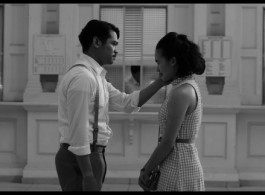BOO JUNFENG & LINDA C.H. LAI
Exhibition Dates 7 May–19 June, 2016 Tuesday–Saturday, 11am–7pm; Sunday, 12–6pm
Venue Pearl Lam Galleries, 9 Lock Road, #03-22, Gillman Barracks, Singapore 108937
Singapore—Pearl Lam Galleries is pleased to present The Third Script, an exhibition featuring works by Singaporean filmmaker Boo Junfeng and Hong Kong artist Linda C.H. Lai, opening on 7 May, 2016. Boo and Lai will come together as two independent artists to present two different ways of deconstructing a narrative. Comprising a site-specific installation and time-based artwork, curated by David H.Y. Chan, this show demonstrates the Galleries’ commitment to supporting experimental projects and providing a collaborative platform that stimulates cross-cultural dialogue.
Both Hong Kong and Singapore, post-colonial city-states, are actively engaging in their own historical projects in an attempt to create a linear historical narrative, thereby securing their respective historical identities. The Third Script actively contradicts the notion that history can be constructed in a linear fashion. By experimenting with the use of micro-narratives, this exhibition reflects on how our identity and recollection of the past are formed.

Boo and Lai, a filmmaker from Singapore and a videographer/artist from Hong Kong respectively, question their own authorship of their work by engaging with time-based media, rendering their practices transparent to their viewers. In doing so, they demonstrate the instability of our individual memories and the impossibility of formulating a collective history.
If the function of a monument is to commemorate a specific historical event, Lai’s site-specific installation Mnemonic Archiving: A Dispersive Monument simulates a real-time archival machine like a perpetual montage. The work is embedded with fragments from old Cantonese movies, found and personal footage from different periods, in used furniture and everyday objects using small tablet screens. The piece is a metaphor for an archaeological dig with the different components connected like a rhizome. Such a juxtaposition denies the object on view of its own importance and refutes a chronological reading of its content.
Boo’s The Scene at the Train Station, a 3-channel projection without sound, features unused footage from his 12-minute short film Parting (2015), which is part of the 7 Letters anthology created in celebration of Singapore’s 50th anniversary. Parting’s plot centres on an elderly Malaysian man, who is suffering from dementia, and his unsuccessful search for a long-lost daughter in Singapore. At the train station on his journey home, he encounters a film set where a young couple is acting out a tearful scene that reminds him of his own past. Boo shows cut footage of the crying scene from three different angles to deconstruct the trope of the film and its master narrative. Shown on three muted screens, we see the subtitles of the director’s instructions to the actor and the actress, orchestrating their emotion for the audience. Boo’s other works in this exhibition include three light boxes featuring the 35mm film version of The Scene at the Train Station, and Parting, which will be screened in its entirety. For Boo, filmmaking as a cinematic construction is inherently fictitious. Our desire for belonging and kinship are carefully crafted by an “auteur”.
Uncertain stories and fractured narratives form the nexus of this exhibition. In reaction to the unquestioned methodology of expressing events in linear time, Boo and Lai question the authority of this truth by presenting alternatives that express the instability of our memories. In doing so, their work is also a reflection of the failed national project of history writing. To both artists, there isn’t a single collective history for Singapore and Hong Kong; history is always multi-threaded and incomplete.
“The blurring of lines between what is real and what is fiction is one of the things I love most about cinema. When we buy into a narrative, it becomes real.”
—Boo Junfeng
“I offer no certainty for what is the past, what is the present, and what lies ahead— except that I was there and I am here, and for likely traces of the future, an emergent presence.”
About the Artists
Boo Junfeng
Boo’s short film Parting was part of 7 Letters, a film anthology commissioned to commemorate Singapore’s 50th year of independence. Boo is the youngest artist included in this anthology, which was also the opening film of the refurbished Capitol Theatre. This exhibition marks his first foray into a gallery space. Previously, Boo participated in the 2013 Singapore Biennale with Happy and Free, and he won the President’s Young Talent Award 2013 for his work Mirror. Boo’s first feature film Sandcastle (2010) was the first Singaporean film accepted at the International Critics’ Week at Cannes Film Festival. His second feature film, Apprentice, has been invited to premiere this year at Cannes Official Selection Un Certain Regard.
Linda C.H. Lai
Founder of the established Hong Kong artist collectives Writing Machine Collective (f. 2004) and Floating Projects (f. 2010), Associate Professor Linda Chiu-han Lai is well known in the Hong Kong contemporary art world. As an educator, she is an influential teacher to the current generation of Hong Kong intermedia artists. She started Hong Kong universities’ first sonic art course in the context of contemporary art and cultural studies, as well as the course Generative Art & Literature, in which experimental literature and code-writing are examined together to illumine the nature of computational thinking.
Curated by
David Ho Yeung Chan is a curator based in Hong Kong . With Pearl Lam Galleries, Chan has curated Tsang Kin-Wah: Ecce Homo Trilogy I (2012), Fictional Recoveries (2012), Su Xiaobai (2013), Déjà Disparu (2013), After Time (2014), Embodied (2014), Ren Ri: Yuansu Projects (2015), Ni Haifeng: Asynchronous, Parallel, Tautological, et cetera… (2015), and Foot and Moon: Suki Seokyeong Kang (2016), among others. He holds an MA from the Center for Curatorial Studies at Bard College, New York, USA.



